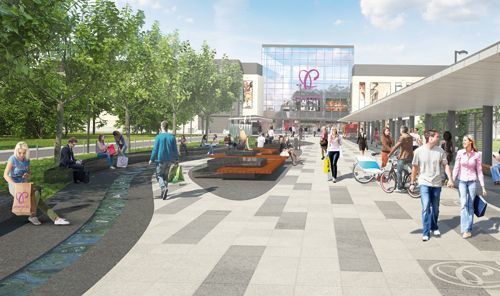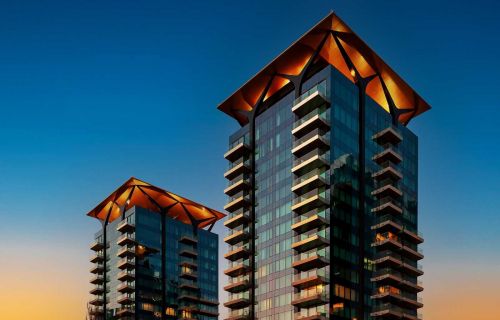The new agoras
Retail & leisure
The development of well-designed, attractive public areas around new shopping centre projects has been gaining in popularity among retail developers and investors in Poland of late, with schemes of this kind now increasingly being seen as bringing dditional value to shopping centre projects. The fierce and growing competition on the retail market in the country is leading property owners to look for new ways of making their centres more distinctive and appealing, as well as attracting and keeping ever larger numbers of visitors and potential consumers. A new public square and a 135m long promenade are to be built as part of the ongoing Posnania shopping centre development in Poznań. Among the functions of the space, which is scheduled to be completed in the next few weeks, will be its use for art exhibitions. A number of other under-construction mall developments in Poland are expected to involve the creation of new public space. These include Galeria Północna in Warsaw, Forum Gdańsk in Gdańsk and Centrum Skałka in Tychy.
Following a global trend
According to Marta Mikołajczyk-Pyrć, an associate director and portfolio manager in the property management team of Savills, developers are now increasingly interested in retail projects that stand out from the competition due to what can be described as their genius loci. She pointed to the popularity of schemes that involve the revitalisation and redevelopment of historic retail buildings, as exemplified by the ongoing Hala Koszyki project in central Warsaw. The creation of new public space around shopping centre developments can be viewed as part of the trend. In the opinion of Marta Mikołajczyk-Pyrć, we are going to see more and more retail projects appearing that combine purely commercial and public functions. However, she notes that the creation of new public space is usually only feasible while developing a new shopping centre from scratch, since many existing malls are located in densely built-up urban areas that offer little room for expansion. According to her, “local authorities have a role to play here – the creation of public space for new shopping centre projects should be provided for in zoning plans. However, schemes combining retail with public space often involve a conflict of interests,” she admits. While the local authorities usually welcome new public space that private investors can deliver at their own cost while insisting that the space has a non-commercial nature, the investors often want to carry out some kind of profit-generating activity within the public area they have developed. Anna Wysocka, the director of the retail leasing department at JLL in Poland, points out that the development of new public space around shopping centres is a global trend. “Poland is following in the wake of more developed retail markets, for example, in Western Europe,” she says. “The market in Poland has been evolving – we have come a long way from the simple hypermarket-dominated galleries of the 1990s to the multi-functional projects of today that offer much more than just shopping,” adds JLL’s expert.
Changing shopping habits
Magdalena Frątczak, a senior director in the retail department for advisory and transaction services at CBRE, also argues that the increased developer interest in the space around shopping centres has much to do with the changing consumer habits of Poles. She points to the growing significance of the restaurant component in malls and the corresponding increase in the demand for outdoor space that restaurants generate. “Shopping centres are no longer places where one just shops, but are also places where one eats and goes to the cinema,” she claims. Additionally, there is more and more talk on the market of the growing attractiveness and popularity of high street retail in Poland. In a way, the public space around a shopping centre is meant to generate the atmosphere found on a high street, according to Magdalena Frątczak. “Admittedly, it is only the shopping centres in downtown locations, rather than the malls located on the outskirts of cities, that are in competition with high street retail facilities,” says the CBRE expert. But the location itself is not enough – the space simply has to be of a high quality. “Many of the first modern shopping centres in Poland were developed in relatively unattractive suburban locations and were mostly targeted at visitors travelling to them by car. This is why they were often not, in architectural terms, integrated with the districts they were built in. By contrast, some of the best shopping centre projects developed today are in inner-city locations and supplement the existing functions there,” argues Andrzej Jarosz, the marketing and communications director of Mayland Real Estate. In such locations, the integration of a new shopping centre project with the existing neighbouring buildings is a necessity – it allows the developer to take advantage of the existing pedestrian traffic and to boost the footfall of the mall, claims Andrzej Jarosz. He adds that the Serenada shopping centre, which Mayland Real Estate is currently developing in Kraków, will also include new publicly-accessible space outside the building, which will be integrated with the neighbouring Multikino and the Park Wodny swimming complex. In the opinion of Marcin Materny, the shopping centre projects department director at Echo Investment: “The development of new public space around retail schemes is no longer perceived by developers as a necessary evil. The market has matured enough for retail developers and investors themselves to understand that the delivery of retail space alone is not what mall visitors of today expect.” Echo Investment plans to include new public space in its projects, including Galeria Libero in Katowice and the development planned on the Jupiter site in Warsaw. He stresses that in both locations the developer will do much more than the local authorities have asked for. In Katowice, Echo Investment is to redevelop and revitalise at its own expense a plot owned by the city. In the Wola district of Warsaw, where the Jupiter site is located, the premises to be redeveloped are owned by the company but will be accessible to the public around the clock. Echo Investment will, among other things, reconstruct a public square that used to exist on the site before World War II. “The retail investment planned there will be competing with existing nearby shopping centres, such as Arkadia and Złote Tarasy, so if the mall is to be successful its range of goods, services and attractions simply has to be exceptional,” believes Marcin Materny. The public space around a shopping centre is, first and foremost, intended as a meeting place featuring greenery, fountains, children’s playgrounds, as well as outdoor furniture and ornamentation, and should be attractive for the inhabitants of the town or city the mall is located in. “The space should meet the needs of the local community and complement the architecture of the neighbouring area. Of course, it should not compete with, but rather supplement, the commercial space of the given mall,” suggests Anna Wysocka of JLL. Dariusz Alot, a planning manager at ECE Projektmanagement Polska, is of the view that it is important that the public space located around shopping centres “corresponds with the space inside these malls, which is also a kind of public area, only located on private ground. The high quality public space situated around shopping centres guarantees safety, cleanliness and comfort, and thus becomes more attractive than the traditional public space found in a city. In this way, every visitor becomes a potential customer,” he explains.
Boosting footfall and turnover
Of course, the development of high quality public space around a shopping centre generates additional costs for the developer, “but these are not huge, compared with the total financial outlay the designing and building of the mall requires,” Anna Wysocka notes. Asked about the cost of building the public space around Posnania, Maciej Wróblewski, the vice-president of the management board of developer Apsys Polska, came up with the figure of PLN 90 mln. “By comparison, the total value of the investment amounts to around EUR 300 mln,” he adds. Nevertheless, well-designed public space can be an asset that brings additional value and helps a shopping centre project to stand out from the crowd. “This could be crucial in the face of the growing competition in the retail sector,” says Maciej Wróblewski. He emphasises that the public space itself does not generate much revenue for the shopping centre owner. However, “the better footfall that the space brings means higher turnover rates – and in this sense an investment of this kind will sooner or later pay off,” he concludes.





















































